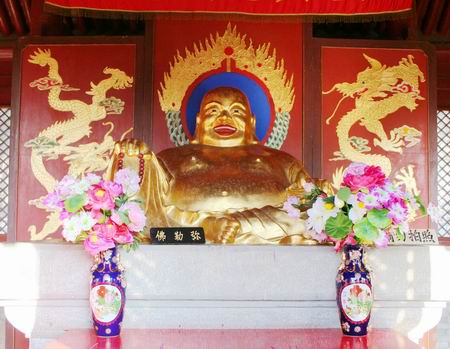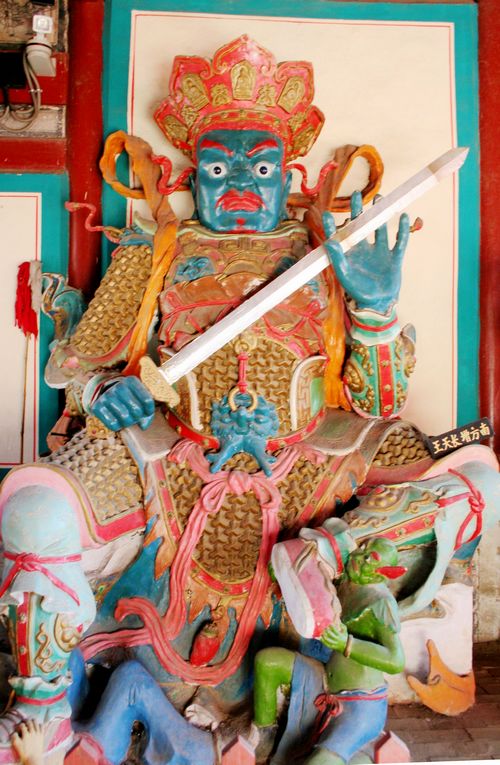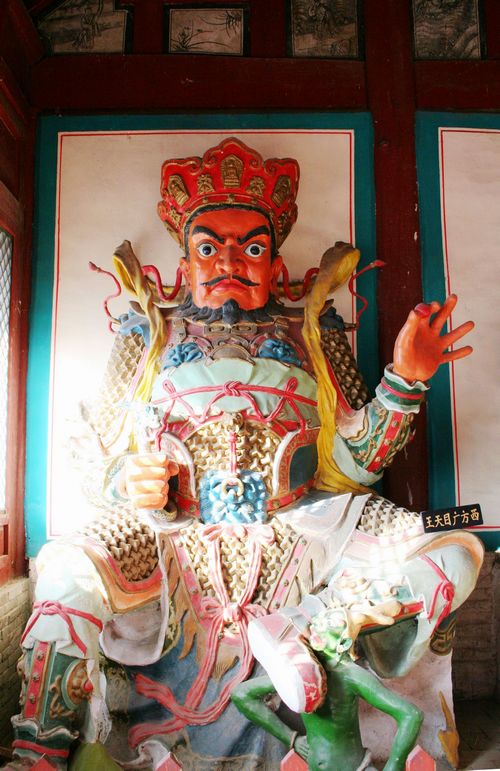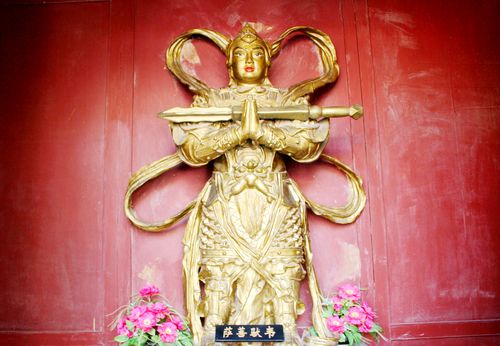5.The Hall of Heavenly Guardians
Maitreya sits in the center of the Hall of Heavenly Guardians flanked by the four heavenly guardians. At his back, Skanda Bodhisattva is enshrined.

Maitreya
Maitreya is the successor of Sakyamuni, the founder of Buddhism. At present he has not become a Buddha. Though his title is still Bodhisattva, he is the “coming one”.
The statue of Maitreya monk enshrined in Chinese temples is created with the image of Cloth-bag Monk, who is regarded as the incarnation of Maitreya. The Cloth-bag Monk, named Qici(?—916), is an ascetic monk in Fenghua, Zhejiang province in the Five Dynasties period. He is plump, always carrying a cloth bag and a broad smile when begging in the street. He puts everything he gets into the bag. While begging, he often seeks to moralize the people, which wins him their admiration and confidence. In the second year of the reign of Zhen Ming Emperor in late Liang Dynasty(the year 916), he dies on a rock in the east corridor of Yuelin Temple in Fenghua. Before he passes away, he chants a Buddhist’s hymn: Maitreya, oh, Maitreya, you appear on earth in billions of incarnations; You show people your incarnation, but they cannot recognize you. Therefore, people regard him as the incarnation of Maitreya. As his geniality and smile can help smooth away the severity of the atmosphere in the temple, his statue has been consecrated in the first Buddha hall since Ming and Qing Dynasties, telling people that paying respect for Buddha, worshiping Buddhism and practicing Dharma are sacred, and happy as well. The couplet going “ A big stomach can include all the intolerable things; he always wears a broad smile and laughs all the ridiculous people out of court” gives the best expression to the Maitreya.
Four Heavenly Guardians
Four Heavenly Guardians belong to the twenty Buddhist heavenly kings who protect the law. Since Buddhism was introduced to China, the Four Heavenly Guardians have been localized with Chinese characteristics unavoidably. Their armor and instruments are changed and they are granted the duty of maintaining proper amounts of wind and rain. Thus, they become the spiritual sustenance of the Chinese people for harvests and peace.

The heavenly guardian of the east, charged with the responsibility of shielding the territory, holds a Chinese lute which represents responsibility, order and harmony.

The heavenly guardian of the south, responsible for enhancing people’s kindness, carries a sword which stands for bravery, exploration and excellence.

The heavenly guardian of the west, in charge of observing the earthly world and protecting the people, holds a dragon which represents agility and observation.

The heavenly guardian of the north, the most mighty one of the four guardians, accountable for protecting the people with fortune and virtue and learning about issues in the world, possesses an umbrella which symbolizes peace and being free from evils and worries.

Bodhisattva Skanda
At the back of the Hall of Heavenly Guardians stands a Bodhisattva named Skanda. He is one of the twenty Buddhist heavenly kings who protect the law and the real protector of this temple.
The statue of Skanda in Chinese temples is in the image of a typical Chinese young warrior. There are generally two types of gestures for him: putting his palms together with the pestle lying on his wrist, a sign of reception. The gesture shows that the temple can accommodate wandering monks; leaning on the pestle with one hand and resting the other hand on the hip, a sign of refusal. This gesture indicates that the temple serves monks in this temple exclusively. Therefore, Skanda does not only protect the Buddha dharma but also shows the type of the temple.



